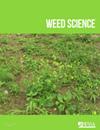麦草畏除草剂在大气中的沉积会对敏感的大豆造成伤害
IF 2.1
2区 农林科学
Q2 AGRONOMY
引用次数: 0
摘要
自 2017 年以来,除草剂麦草畏已经伤害了美国数百万公顷的敏感植物物种。这种伤害与抗麦草畏大豆(Glycine max (L.) Merr.)和棉花(Gossypium hirsutum L.)的商业化同时发生。我们对密苏里州 12 个大豆产区的麦草畏大气沉降量和质量流量进行了量化。在农业密集喷洒期间收集的每周沉积物样本中都会定期检测到麦草畏。观察到的浓度表明麦草畏在当地(1 公里)通过空气传播。密苏里州东南部每年都会发生高沉积事件(> 100 µg m-2),在这些地点沉积的麦草畏峰值(12.5-84.0 µg m-2)足以伤害非麦草畏抗性大豆。抗麦草畏作物的采用率和大气稳定性在很大程度上解释了变异,而除草剂产品标签很难解决这些变量。总之,这些结果表明,麦草畏通常在生长季节从大气中沉降,观测到的浓度和通量与降雨事件的时间和规模以及收集地点附近的麦草畏使用量密切相关。本文章由计算机程序翻译,如有差异,请以英文原文为准。
Atmospheric deposition of dicamba herbicide can cause injury to sensitive soybean
The herbicide dicamba has injured millions of hectares of sensitive plant species in the United States since 2017. This injury has coincided with the commercialization of dicamba-resistant soybean [Glycine max (L.) Merr.] and cotton (Gossypium hirsutum L.). We quantified atmospheric deposition and mass flux of dicamba in 12 soybean production regions of Missouri. Dicamba was routinely detected in weekly deposition samples collected during agriculturally-intensive spray periods. Observed concentrations were indicative of both local (<1 km) and long-distance transport (>1 km) of air-borne dicamba. High deposition events (>100 µg m-2) occurred annually in southeast Missouri, and peak dicamba deposited at these sites (12.5-84.0 µg m-2) was sufficient to injure non-dicamba resistant soybean. Adoption rate of dicamba-resistant crops and atmospheric stability explained much of the variance, and it is difficult for a herbicide product label to address these variables. Overall, these results demonstrated that dicamba was commonly deposited from the atmosphere during the growing season and observed concentrations and fluxes were strongly related to the timing and magnitude of rainfall events, and the amount of dicamba usage near collection sites.
求助全文
通过发布文献求助,成功后即可免费获取论文全文。
去求助
来源期刊

Weed Science
农林科学-农艺学
CiteScore
4.60
自引率
12.00%
发文量
64
审稿时长
12-24 weeks
期刊介绍:
Weed Science publishes original research and scholarship in the form of peer-reviewed articles focused on fundamental research directly related to all aspects of weed science in agricultural systems. Topics for Weed Science include:
- the biology and ecology of weeds in agricultural, forestry, aquatic, turf, recreational, rights-of-way and other settings, genetics of weeds
- herbicide resistance, chemistry, biochemistry, physiology and molecular action of herbicides and plant growth regulators used to manage undesirable vegetation
- ecology of cropping and other agricultural systems as they relate to weed management
- biological and ecological aspects of weed control tools including biological agents, and herbicide resistant crops
- effect of weed management on soil, air and water.
 求助内容:
求助内容: 应助结果提醒方式:
应助结果提醒方式:


